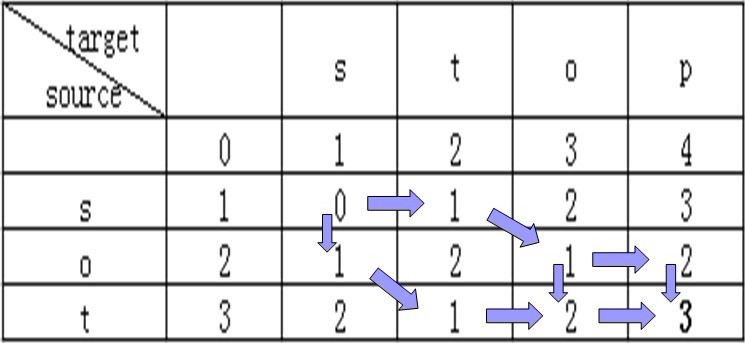Introduce
Through the following, u will know what's edit distance.
target : you are cute and I love u.
source: I am cute I don't love u.
For the two sentences, u can use edit including insert, delete and substitute the source so that it can be same to the target.
u will subsutitute "you" for "I", which will cost 2
subsutitue "are" for "am", which will cost 2
insert "and", which will cost 1
delete "don't", which will cost 1
so, totally, u will cost 2 + 2 + 1 + 1 = 6, which is the edit distance.
How to calculate the minimum edit distance
Now, we take another example
target : s t o p
source: s o t
u can insert "t", which will cost 1, to get "stot", then u can substitute "p" for "t", which will cost 2, to get "stop".
Besides, u can substitue "t" for "o" to get "stt", then u can substitute "o" for "t" to get "sto", last, u can insert "p" to get "stop"
Alright, u can have plenty of method to edit to get the target, so how to get the minimum edit distance. We will introduce the algorithm as following, which is dynamic programming.
i : the length of the target
j : the length of the source
D(0, 0) = 0
D(i, 0) = insertCost * i, means the length of the target is i and the length of the source is 0, so u should insert i characters
D(0, j) = deleteCost * j, means the length of the target is 0 and the length of the source is j, so u should delete j characters
D(i, j) = min {D(i - 1, j) + insertCost(target[i]);
D(i - 1, j - 1) + substituteCost(source[j], target[i]);
D(i, j - 1) + deleteCost(source[j])} means u should choose the method which will cost least.substituteCost = {0, 2}, if source[j] is equal to target[i], it's 0, or it's 2.
insertCost = 1
deleteCost = 1
Well, maybe u will feel confuse, but no problem, We will use the algorithm to solve the above question.
firstly, u can gain the belew form.

D(1, 1) = min {D[0, 1] + insert(t[1]) = 2;
D[0, 0] + substitute(s[1], t[1]) = 0;
D[1, 0] + delete(s[1]) = 2} = 0

D[1, 2] = min{ D[0, 2] + insert(t[1]) = 3;
D[0, 1] + substitute(s[2], t[1]) = 3;
D[1, 1] + delete(s[2] = 1)} = 1

................
then u will get the last number
D[4, 3] = min {D[3, 2] + insert(t[4]) = 3;
D[3, 2] + substitute(s[3], t[4]) = 3;
D[4, 2] + delete(s[3]) = 3} = 3

Actually, u can get the path how to get edit through every step. The below picture show the results.
